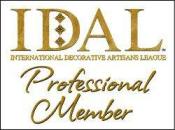About Your Instructor: Nationally recognized, Jeannine Dostal is a true artist with vision and a passion for faux and fresco's. Jeannine has a Bachelor of Science (BS) degree in Fashion/Apparel Design from the University of Cincinnati and has been a professional faux finisher for 13 years. Her work has appeared in many home decorating magazines as well as in the book "Simply Creative Paint Finishes with Gary Lord" and she is the author of "Spectacular Walls". Jeannine is known for Fresco's. She learned authentic Fresco from Master's in Nice, France, has taken and taught classes in America and Italy, and has painted in Florence and Sienna with a team of artists. A short list of some of the locations where Jeannine has taught her fabulous techniques includes the International Decorative Artisans League Convention, Prismatic Painting Studio, and Faux Effects Studio Vero Beach.
What Jeannine says about herself: "I am a passionate artist who loves life and all its adventures. I am inspired by colors and textures, art and architecture, the practice of yoga, freedom, animals and nature, travel, great food, music and laughter. My goal is to create an enviroment that brings personal style and beauty to home owners as well as commercial spaces. For my artist's soul, there is nothing as beautiful, fluid and charming as something that is hand painted. It's faster, for me, than stenciling or measuring and taping off the wall. I use the curves and indentations of the molding and start and stop color where those curves and indentations start and stop. Make this as fun and easy as possible."
Some Historical Information:
Rome - The Room of Livia, built at the beginning of the Empire, is one of the great indoor spaces of ancient Rome which is still visible today. As wife and business partner of the first emperor Caesar Augustus (or Octavian), the dinners that she hosted here which often lasted for days are legendary. In addition to her hospitality and being a gourmet, classical sources describe her as a renowned master gardener as well.
The dining room (triclinium) was located in the deep underground of her villa, probably for cool summer banquets. Its temperature was so stable, winter or summer, that the frescoes (the most ancient example of continuous garden painting 30 - 20 BCE) are incredibly well preserved, with color and detail intact even after two millenia. The frescoes depict early Empire flora, landscape, and bird life, and show an idealized night view of her other garden above ground, but with everything in bloom simultaneously. She was a gardener's gardener!
More Historical Information:
A peristyle courtyard was a popular feature of ancient Roman villas. Surrounded by a covered walkway, this interior garden space was sometimes set at the back of a house, but more often at the very center, where it provided much needed light and ventilation. Gardens frequently included small sculptures and fountains in addition to a diverse range of plant life. During the early imperial period, gardens also became popular motifs for murals painted on the walls of villa interiors.
An 1863 excavation of the house of Livia Drusilla (58 BCE–29 CE), wife of the Emperor Augustus, in the Roman suburb of Prima Porta uncovered a series of four magnificent frescoes decorating the walls of an underground triclinium, or dining room. These illusionistic wall paintings are filled with images of exotic birds and a variety of flowers, plants, and trees. The flora and fauna were, in fact, depicted in such great detail that scholars have been able to identify many of the species represented. Among the vegetation, for instance, are strawberry trees, oleander, Italian cypresses, date palms, and English oak. These images were surely intended to provide visual entertainment for guests and likely contributed a sense of comfort and openness to the subterranean space. However, it has also been suggested that this natural imagery functioned on a symbolic level as well.
One of the most abundantly represented plants in the so-called Garden Room is the bay laurel, a type that held special significance for Livia. In the ancient world, Livia’s house was known as the Villa ad Gallinas Albas (House of the White Hen). As related by Pliny the Elder (23–79 CE) in his Historia Naturalis (Natural History), when Livia was newly betrothed, a white hen holding a laurel branch in its beak dropped into her lap. The event was interpreted as an omen of good fortune, laurel being not only a symbol of peace and victory, but also, as an evergreen, associated with virtue and immortality. Livia supposedly planted the branch, which eventually yielded an entire laurel grove on the Prima Porta estate. Augustus was also closely linked with the laurel tree, using it frequently a symbol of his reign, which brought unprecedented peace and prosperity to Rome.
IMPORTANT WORKSHOP INFORMATION:
There will be a $35 material fee in addition to the class fee that will include the prepared canvas and a brush set to keep and be used for the creation of your fresco canvas mural. The workshop will begin with an optional evening session at the Sarasota School of Faux & Archtectural Finishing on Wednesday the 17th of October from 6-8pm. Jeannine will demonstrate her technique for applying a Faux Effects Plaster to your prepared canvas to replicate the fresco texture that forms the background of your mural, the base for all your application and detail painting techniques. You will have time to complete this layer on your canvas and enjoy meeting your instructor and your fellow students. A bit of Italian Wine, cheese, and fun will be served to accompany your work time and help you find your alter-Italian-ego. This session will allow for overnight drying time so your canvas will be ready for you to move forward on Thursday morning. Please let us know if you are unable to attend this session so that Donna or Jeannine may complete this layer for you but we hope you will all make arrangements to be here for this fun start to your workshop. It won't be the same without you!
REGISTRATION INFORMATION:
Call 1-888-454-3289 to register, 50% deposit is required to register with the balance due 14 days prior to workshop start date. Workshop hours 9:30 to 5:30 unless otherwise specified by the instructor. Complimentary continental breakfast and snacks provided. Airfare and accommodations not included. Special hotel rates have been secured for workshop attendants. *Sarasota School of Faux & Architectural Finishing does not make any warranty or representation that the finishes, products or results advertised will meet your individual requirements or expectations. Every effort is made to conduct all Sarasota School of Faux & Architectural Finishing Workshops as advertised; however, the products and finishes taught may vary. Copyright© 2012, Sarasota School of Faux & Architectural Finishing. All Rights Reserved. The reproduction of any part of this website without Sarasota School of Faux & Architectural Finishing express written permission is strictly prohibited.
































